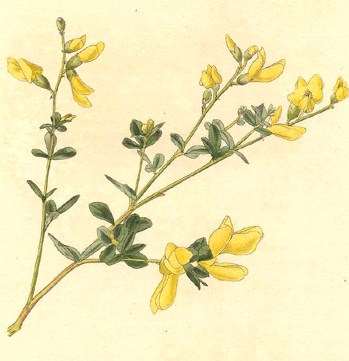
Baptisia tinctoria (R.Br.)
 Synonyms: Sophora tinctoria (L.), Podalyria
tinctoria (Michx.), indigo weed, false indigo, yellow indigo, horsefly weed,
American indigo, indigo broom, rattlebush, baptisia
Synonyms: Sophora tinctoria (L.), Podalyria
tinctoria (Michx.), indigo weed, false indigo, yellow indigo, horsefly weed,
American indigo, indigo broom, rattlebush, baptisia
Order: Leguminosae
Description: Baptisia is a perennial plant growing to a height of 1.3m, with erect, slender branches bearing alternate greyish-green trilobar leaves with three obovate leaflets and bright yellow leguminous flowers in loose terminal racemes. It grows in dry soil in woods and clearings of central and eastern North America.
Parts used: root
Collection: The root is unearthed in the autumn after flowering.
Constituents: flavonoids (flavones and isoflavones), alkaloid (cytisine, baptitoxin), glycosides, oleoresin, coumarins, resin
Actions: antimicrobial, antipyretic, antiseptic, mild cardioactive agent, anticatarrhal, febrifuge, circulatory stimulant, anti-infective, alterative, chologogue, laxative, astringent, emetic
Indications: tonsillitis, pharyngitis, acute catarrhal infections, lymphadenitis, furunculosis, aphthous ulcers, stomatitis, gingivitis, fevers; topically for indolent ulcers, sore nipples, douche for leucorrhoea. Specifically indicated in infection of the upper respiratory tract.
Therapeutics and Pharmacology: Baptisia is of value in the treatment of infections and catarrh of the ear, nose and throat. It may be used for laryngitis, tonsillitis, pharyngitis and catarrhal infections of the nose and sinus. Taken both internally and as a mouthwash it will help to heal mouth ulcers and gingivitis. Systemically, it is used to treat enlarged and inflamed lymph glands and also to reduce fevers. Externally an ointment will help infected ulcers and boils, and will ease sore nipples. A douche of the decoction will help leucorrhoea.
Combinations: For the treatment of infections Baptisia may be used with Echinacea and Commiphora. For lymphatic problems it can be combined with Galium or Phytolacca.
Caution: Large doses have caused poisoning, and have a purgative and emetic effect.
Preparation and Dosage: (thrice daily)
Regulatory status GSL
Dried root: 0.5-1g or y decoction
Liquid extract: 1:1 in 60% alcohol, 0.3-1.3ml
Tincture BPC (1934) 2-5ml
Additional Comments: The plant takes its name from the Greek bapto, to dye.
Bibliography
BHMA 1983 British Herbal Pharmacopoeia, BHMA, Bournemouth.
Grieve, M. 1931 A Modern Herbal, (ed. C.F. Leyel 1985), London.
Hoffmann, D. 1990 The New Holistic Herbal, Second Edition, Element, Shaftesbury.
Lust, J. 1990 The Herb Book, Bantam, London.
Mabey, R. (ed.) 1991 The Complete New Herbal, Penguin, London.
Mills, S.Y. 1993 The A-Z of Modern Herbalism, Diamond Books, London.
Polunin, M. and Robbins, C. 1992 The Natural Pharmacy, Dorling Kindersley, London.
Wren, R.C. 1988 Potter's New Cyclopaedia of Botanical Drugs and Preparations, C.W.Daniel, Saffron Walden.










